Search results for: 'Machine+c''
- Related search terms
- Machine+c'[0]
- Machine+c''
-
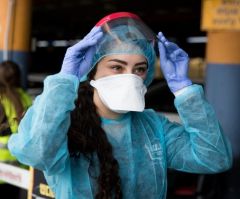 H-2366 MASK AND MEDICAL GOWN LABORATORY EQUIPMENT
H-2366 MASK AND MEDICAL GOWN LABORATORY EQUIPMENTREFERENCE NUMBER: T-6334
Learn More
ALL KINDS OF MASK TESTING INSTRUMENTS
(SURGICAL MASK)
(DISPOSABLE SURGICAL MASK)
(MEDICAL PROTECTIVE MASK)
(DAILY PROTECTIVE MASK)
ITEM 001
COMPREHENSIVE TENSION TESTER FOR SURGICAL MASK
ITEM 002
MASK SYNTHETIC BLOOD PENETRATION DETECTOR
ITEM 003
BACTERIAL PERCOLATION EFFICIENCY (BFE) TESTER
ITEM 004
PARTICLE EFFICIENCY (PFE) TESTER
ITEM 005
RESPIRATOR RESISTANCE TESTER
ITEM 006
MASK FLAME RETARDANT PERFORMANCE TESTER
ITEM 007
FABRIC SURFACE MOISTURE TESTER
ITEM 008
MASK AIR TIGHTNESS TESTER
ITEM 009
TEMPERATURE PRETREATMENT CONSTANT TEMPERATURE AND HUMIDITY CHAMBER
ITEM 010
COLOR FASTNESS TO FRICTION TESTER
ITEM 011
TEXTILE FORMALDEHYDE TESTER
ITEM 012
PH METER
REFERENCE NUMBER: T-6335
RESPIRATORY PROTECTIVE EQUIPMENT & SELF-IMBIBITION FILTER ANTI-PARTICULATE RESPIRATOR TESTING INSTRUMENTS
ITEM 001
FIITRATION EFFICIENCY N CLASS SODIUM CHLORIDE PARTICLES, P CLASS OIL PARTICLES
PARTICLE RATE EFFICIENCY TESTER
ITEM 002
RESPIRATOR RESISTANCE TESTER
ITEM 003
BREATHING VALVE TIGHTNESS TESTER
ITEM 004
AXIAL TENSION TESTER FOR BREATHING BONNET
ITEM 005
AXIAL TENSION TESTER FOR BREATHING BONNET
ITEM 006
MASK FIELD TESTER
ITEM 007
HEADBAND TENSILE TESTING MACHINE
ITEM 008
JOINT PARTS&AXIAL TENSILE TESTING MACHINE
ITEM 009
MASK FLAME RETARDANT PERFORMANCE TESTER
ITEM 010
TEMPERATURE PRETREATMENT CONSTANT TEMPERATURE AND HUMIDITY CHAMBER
REFERENCE NUMBER: T-6336
MEDICAL DISPOSABLE PROTECTIVE CLOTHING TESTING INSTRUMENTS
ITEM 001
WATER PENETRATION RESISTANCE TESTER FOR PROTECTIVE CLOTHING
ITEM 002
MOISTURE PERMEABILITY TESTER FOR PROTECTIVE CLOTHING
ITEM 003
SURFACE MOISTURE RESISTANCE TESTER
ITEM 004
ANTISYNTHETIC BLOOD PENETRANT DETECTOR
ITEM 005
TENSILE TESTER FOR BREAKING STRENGTH AND ELONGATION
ITEM 006
FLAME RETARDANT PERFORMANCE TESTER FOR PROTECTIVE CLOTHING
ITEM 007
FRICTION ELECTRIFICATION TESTER FOR PROTECTIVE CLOTHING (FRENCH LADLE)
REFERENCE NUMBER: T-6337
DISPOSABLE MEDICAL RUBBER INSPECTION GLOVES TESTING INSTRUMENTS
ITEM 001
PLASTIC FILM THICKNESS TESTER
ITEM 002
RUBBER GLOVES TENSILE STRENGTH TESTER
ITEM 003
RUBBER GLOVES WATERPROOF TESTER
ITEM 004
RUBBER GLOVES PRETREATMENT AGING BOX
More information is available upon request.
E-mail us for price, pictures, video, or diagram.
Include our reference number -
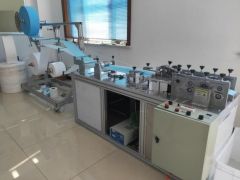 J-2788 SEMI-AUTOMATIC DISPOSABLE FLAT MASK PRODUCTION LINE
J-2788 SEMI-AUTOMATIC DISPOSABLE FLAT MASK PRODUCTION LINE3 LAYER MASKS CONSTRUCTED OF NONWOVEN AND MELTBLOWN FABRIC
MASK DIMENSIONS: 175 x 95mm (ADULT) & 145 x 90mm (CHILD)---COMPOSED OF TWO MACHINES, AS BELOW
1) AUTOMATIC MASK LAYER MAKING AND CUTTING MACHINE
CAPACITY: 200 TO 300 PIECES PER MINUTE
INCLUDES
• MATERIAL FEEDING FRAME
• MACHINE FRAME
• ALUMINUM NOSE STRIP INSERTION
• ULTRASONIC WELDING
• CONVEYOR
DIMENSIONS: 4600 x 500 x 2100mm
WEIGHT: 300 KGS
POWER: 220 VOLTS, 50 Hz (OR AS PER CUSTOMER)
2) MANUAL EAR BAND WELDING MACHINE
CAPACITY: 30 TO 40 PIECES PER MINUTE
INCLUDES
• WORKBENCH
• LIGHT
• AIR CYLINDER
• ULTRASONIC GENERATOR
• CONTROL SYSTEM
DIMENSIONS: 800 x 500 x 1000mm
WEIGHT: 43 KGS
POWER: 380 VOLTS, 50 Hz (OR AS PER CUSTOMER)WARRANTY: 1 YEAR FOR MAJOR COMPONENTS, LIFELONG SERVICE FOR THE USER
QUANTITY: 1 COMPLETE SEMI-AUTOMATIC LINE
Learn More -
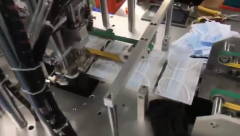 J-2779-B SEMI-AUTOMATIC FACE MASK EAR STRAP WELDING MACHINE, 60 PIECES PER MINUTE -This machine fastens the ear straps to masks only. For mask production, See J-2778
J-2779-B SEMI-AUTOMATIC FACE MASK EAR STRAP WELDING MACHINE, 60 PIECES PER MINUTE -This machine fastens the ear straps to masks only. For mask production, See J-2778SEMI-AUTOMATIC BLANK FACE MASK EAR STRAP WELDING MACHINE
ULTRASONICALLY WELDS EAR STRAPS TO FACE MASK BLANKS
MASK DIMENSIONS: 175 x 95mm
CAPACITY: 60 PIECES PER MINUTE
POWER: 3 KW
DIMENSIONS: 1950mm L x 7000mm W x 1620mm H
WEIGHT: 200 KGSAUTOMATIC FEEDING OF ELASTIC STRAP USED FOR EAR LOOPS
AUTOMATIC CUTTING OFF OF MANUAL LOADING AND UNLOADING
FLEXIBLE CONFIGURATION WITH EASY CONTROLTWO SIZES OF MASKS CAN BE WELDED SIMULTANEOUSLY, SAVING TIME AND LABOR
MANUAL LOADING & UNLOADING
VERY EFFICIENT, LOW FAILURE RATE
WEIGHT OF MACHINE WHEN PACKED FOR AIR FREIGHT : 200 kgs
DIMENSIONS OF MACHINE WHEN PACKED FOR AIR FREIGHT: 2000 x 700 x 1650mmQUANTITY: 1
Learn More -
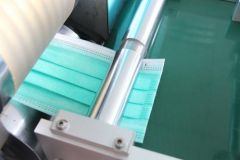 J-2752 FACE MASK PRODUCTION MACHINE – 120 PIECES PER MINUTE
J-2752 FACE MASK PRODUCTION MACHINE – 120 PIECES PER MINUTECOMPOSED OF
FACE MASK BLANK MAKING MACHINE
AUTOMATICALLY PRODUCES THE MAIN PART OF THE MASK
MACHINE HANDLES FEEDING, ALUMINUM STRIP INSERTION, CUTTING, FOLDING, ULTRASONIC WELDING, CUTTING
OUTPUT: 120 PIECES PER MINUTE
VOLTAGE: 220 VOLTS
POWER CONSUMPTION: 2.7 KW
DIMENSIONS: 3345 x 630 x 1830mm
CAN PRODUCE 3 TO 4 DIFFERENT MASK BLANKS ACCORDING TO PRODUCTION REQUIREMENTS
FOLDING LOCATION AND SIZE OF MASK IS ADJUSTABLE
COMPUTER CONTROLS AND PHOTOELECTRIC DETECTION ENSURE LOW FAILURE RATE AND HIGH RELIABILITY
FRAME CONSTRUCTED OF ALUMINUM ALLOY
QUANTITY: 1FACE MASK TRANSFERRING MACHINE
TRANSFERS THE MASKS TO THE ULTRASONIC EAR STRAP WELDING MACHINE
QUANTITY: 1ULTRASONIC EAR STRAP WELDING MACHINE
WELDS THE ELASTICS ON BOTH EDGES OF THE MASK
AUTOMATIC COUNTING
AUTOMATICALLY CONVEYS THE FINISHED MASKS TO PACKING PROCESS (PACKING BY HAND)
COMPUTER CONTROLS AND PHOTOELECTRIC DETECTION ENSURE LOW FAILURE RATE AND HIGH RELIABILITY
FRAME CONSTRUCTED OF ALUMINUM ALLOY
QUANTITY: 2PRODUCES MASKS WITH DIMENSIONS: 175mm x 95mm (ADULT SIZE)
FOR MASK TYPES: 2 LAYERS OF NONWOVEN CLOTH, 3 LAYERS OF NON-WOVEN FABRIC MASKS, 4 LAYERS OF ACTIVATED CARBON MASKS
• 2 LAYER FACIAL MASK: NONWOVEN, ALUMINUM STRIP, EAR STRAP WELDING
• 3 LAYER FACIAL MASK: NON-WOVEN, ALUMINUM STRIP, EARLOOP WELDING, FILTER COTTON (FILTER PAPER)
• ACTIVATED CARBON MASKS: NONWOVEN, ALUMINUM STRIP, EARLOOP WELDING, FILTER COTTON (FILTER PAPER), ACTIVATED CARBON CLOTHTECHNICAL PARAMETERS
OVERALL DIMENSIONS: 6500 L x 4000 W x 2000 H (mm)
PRODUCTION EFFICIENCY: 95%
PRODUCT SIZE: 175 x 95mm (ADULT SIZE)
FACIAL MASK LAYERS: 3 TO 4 LAYERS
POWER: 9 KW
AIR PRESSURE REQUIRED: 0.6 MPA
AIR CONSUMPTION: 300 LITERS PER MINUTE
WEIGHT: APPROXIMATELY 1800 KG
GROUND WEIGHT BEARING: ≤ 500KG/m2
ALL OF THE MAIN DRIVING PARTS ARE PROTECTED BY PROTECTIVE COVERQUANTITY: 1 COMPLETE LINE
Learn More -
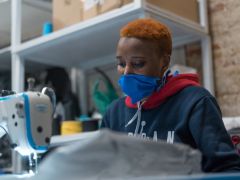 D-2388 What’s the Best Material for a Mask?
D-2388 What’s the Best Material for a Mask?Federal health officials have now recommended that we cover our faces with fabric during the coronavirus pandemic. But what material offers the most protection?
The Centers for Disease Control and Prevention has posted a no-sew mask pattern using a bandanna and a coffee filter as well as a video on making masks using rubber bands and folded fabrics found at home.
While a simple face covering can reduce the spread of coronavirus by blocking outgoing germs from coughs or sneezes of an infected person, experts say there is more variation in how much homemade masks might protect the wearer from incoming germs, depending on the fit and quality of the material used.
Scientists around the country have taken it upon themselves to identify everyday materials that do a better job of filtering microscopic particles. In recent tests, HEPA furnace filters scored well, as did vacuum cleaner bags, layers of 600-count pillowcases and fabric similar to flannel pajamas. Stacked coffee filters had medium scores. Scarves and bandanna material had the lowest scores, but still captured a small percentage of particles.
If you don’t have any of the materials that were tested, a simple light test can help you decide whether a fabric is a good candidate for a mask.
“Hold it up to a bright light,” said Dr. Scott Segal, chairman of anesthesiology at Wake Forest Baptist Health who recently studied homemade masks. “If light passes really easily through the fibers and you can almost see the fibers, it’s not a good fabric. If it’s a denser weave of thicker material and light doesn’t pass through it as much, that’s the material you want to use.”
Researchers say it’s important to remember that lab studies are conducted under perfect conditions with no leaks or gaps in the mask, but the test methods give us a way to compare materials. And while the degree of filtration for some homemade masks seems low, most of us — who are staying home and practicing social distancing in public — don’t need the high level of protection required for medical workers. More important, any face covering is better than none, especially if worn by a person who has the virus but doesn’t know it.
The biggest challenge of choosing a homemade mask material is to find a fabric that is dense enough to capture viral particles, but breathable enough that we can actually wear it. Some items being touted online promise high filtration scores, but the material would be unwearable.
Dressing Up for Work … at Home
Yang Wang, an assistant professor of environmental engineering at Missouri University of Science and Technology, worked with his graduate students to study various combinations of layered materials — including both air filters and fabric. “You need something that is efficient for removing particles, but you also need to breathe,” said Dr. Wang, who last fall won an international award for aerosol research.To test everyday materials, scientists are using methods similar to those used to test medical masks, which everybody agrees should be saved for medical workers who are exposed to high doses of virus from seeing infected patients. The best medical mask — called the N95 respirator — filters out at least 95 percent of particles as small as 0.3 microns. By comparison, a typical surgical mask — made using a rectangular piece of pleated fabric with elastic ear loops — has a filtration efficiency ranging from 60 to 80 percent.
Dr. Wang’s group tested two types of air filters. An allergy-reduction HVAC filter worked the best, capturing 89 percent of particles with one layer and 94 percent with two layers. A furnace filter captured 75 percent with two layers, but required six layers to achieve 95 percent. To find a filter similar to those tested, look for a minimum efficiency reporting value (MERV) rating of 12 or higher or a microparticle performance rating of 1900 or higher.
The problem with air filters is that they potentially could shed small fibers that would be risky to inhale. So if you want to use a filter, you need to sandwich the filter between two layers of cotton fabric. Dr. Wang said one of his grad students made his own mask by following the instructions in the C.D.C. video, but adding several layers of filter material inside a bandanna.
Dr. Wang’s group also found that when certain common fabrics were used, two layers offered far less protection than four layers. A 600 thread count pillow case captured just 22 percent of particles when doubled, but four layers captured nearly 60 percent. A thick woolen yarn scarf filtered 21 percent of particles in two layers, and 48.8 percent in four layers. A 100 percent cotton bandanna did the worst, capturing only 18.2 percent when doubled, and just 19.5 percent in four layers.
The group also tested Brew Rite and Natural Brew basket-style coffee filters, which, when stacked in three layers, showed 40 to 50 percent filtration efficiency — but they were less breathable than other options.
If you are lucky enough to know a quilter, ask them to make you a mask. Tests performed at the Wake Forest Institute for Regenerative Medicine in Winston-Salem, N.C., showed good results for homemade masks using quilting fabric. Dr. Segal, of Wake Forest Baptist Health, who led the study, noted that quilters tend to use high-quality, high-thread count cotton. The best homemade masks in his study were as good as surgical masks or slightly better, testing in the range of 70 to 79 percent filtration. Homemade masks that used flimsier fabric tested as low as 1 percent filtration, Dr. Segal said.
The best-performing designs were a mask constructed of two layers of high-quality, heavyweight “quilter’s cotton,” a two-layer mask made with thick batik fabric, and a double-layer mask with an inner layer of flannel and outer layer of cotton.
Bonnie Browning, executive show director for the American Quilter’s Society, said that quilters prefer tightly woven cottons and batik fabrics that stand up over time. Ms. Browning said most sewing machines can handle only two layers of fabric when making a pleated mask, but someone who wanted four layers of protection could wear two masks at a time.
Ms. Browning said she recently reached out to quilters on Facebook and heard from 71 people who have made a combined total of nearly 15,000 masks. “We quilters are very much in the thick of what’s going on with this,” said Ms. Browning, who lives in Paducah, Ky. “One thing most of us have is a stash of fabric.”
People who don’t sew could try a folded origami mask, created by Jiangmei Wu, assistant professor of interior design at Indiana University. Ms. Wu, who is known for her breathtaking folded artwork, said she began designing a folded mask out of a medical and building material called Tyvek, as well as vacuum bags, after her brother in Hong Kong, where mask wearing is common, suggested it. (DuPont, the maker of Tyvek, said in a statement that Tyvek is intended for medical apparel, not masks.) The folded mask pattern is free online, as is a video demonstrating the folding process. In tests at Missouri University and University of Virginia, scientists found that vacuum bags removed between 60 percent and 87 percent of particles. But some brands of vacuum bags may contain fiberglass or are harder to breathe through than other materials, and shouldn’t be used. Ms. Wu used a bag by EnviroCare Technologies, which has said it does not use fiberglass in its paper and synthetic cloth bags.
“I wanted to create an alternative for people who don’t sew,” said Ms. Wu, who said she is talking to various groups to find other materials that will be effective in a folded mask. “Given the shortage of all kinds of materials, even vacuum bags might run out.”
The scientists who conducted the tests used a standard of 0.3 microns because that is the measure used by the National Institute for Occupational Safety and Health for medical masks.
Linsey Marr, a Virginia Tech aerosol scientist and an expert in the transmission of viruses, said the certification method for respirators and HEPA filters focuses on 0.3 microns because particles around that size are the hardest to catch. While it seems counterintuitive, particles smaller than 0.1 microns are actually easier to catch because they have a lot of random motion that makes them bump into the filter fibers, she said.
“Even though coronavirus is around 0.1 microns, it floats around in a wide range of sizes, from around 0.2 to several hundred microns, because people shed the virus in respiratory fluid droplets that also contain lots of salts and proteins and other things,” said Dr. Marr. “Even if the water in the droplets fully evaporates, there’s still a lot of salt and proteins and other gunk that stays behind as solid or gel-like material. I think 0.3 microns is still useful for guidance because the minimum filtration efficiency will be somewhere around this size, and it’s what NIOSH uses.”
Learn More -
 H-2386 ONE-PIECE MASK MANUFACTURING MACHINES
H-2386 ONE-PIECE MASK MANUFACTURING MACHINESONE-PIECE MASK MACHINERY, MADE ON HOSIERY MACHINES
REBUILT, RECONVERTED & UPDATED INTO MACHINES FOR ONE-PIECE MASKSSINGLE CYLINDER MACHINES
WITH FULLY ELECTRONIC CONTROL
DIAMETER: 4”
NEEDLES: 200 TO 400
FEEDS: 4KNITTING PRODUCTION:
• MASKS READY TO WEAR IN ANY SIZE & STYLE
• THEY ARE PRODUCED USING ANY NATURAL YARN,
ECOLOGICAL YARN, ANTIBACTERIAL FIBER, STRETCH FIBERS
• CAN BE CUSTOMIZED WITH DESIGNS, COLORS, LOGOS
• PRODUCTION TIME: FROM 45 SECONDS PER MASKPLAIN FABRIC, RUN PROOF, MICROMESH, NET, REINFORCED BAND, REINFORCED & FLOATED PATTERNS
SINKER CAP WITH STEPPING MOTOR
MASKS ARE COMPLETE WITH A TUBULAR POCKET FOR INSERTING FILTER OR ADDITIONAL FABRIC FOR BETTER PREVENTION
-TUBULAR POCKET DIMENSIONS: 50 X 100mm (FILTERS MAY ALSO BE ROUND SHAPE)
MACHINE WASHABLE AND REUSABLE
MOTORIZED DIAL ARM WITH VERTICAL MOVEMENT THROUGH STEPPING MOTOR FOR
UNLIMITED HEIGHT POSITIONSSTITCH CAMS WITH INDEPENDENT VARIABLE PROFILE SYSTEM
SYSTEM ON YARN FINGERS FOR PLATING CONTROL
ELECTRONIC NEEDLES & NEEDLES SELECTION ON 4 FEEDS
PROGRAMMABLE & VARIABLE STITCH CAM LOWERING IN DIFFERENT AREAS
BY STEPPING MOTOR ON EACH FEED
ALL FUNCTIONS ELECTRONICALLY CONTROLLED
PROGRAMMING STYLES & SIZE, PATTERNS EDITING & STITCH CAM LOWERING BY PERSONAL COMPUTER
AND POWERFUL GRAPHIC SOFTWARE FOR WINDOWS ENVIRONMENT.
KEYBOARD WITH GRAPHIC DISPLAY FOR SELECTION OF STYLE, SIZE , PATTERNS & OTHER FUNCTION
PRE-SETTING AND PROGRAMMING FOR DIFFERENT KINDS OF YARNS FEEDING DEVICEDIMENSIONS: 1000mm L x 1000mm W x 2500mm H
Learn More
SHIPPING WEIGHT: 350 KG, ON PALLETS
SHIPPING DIMENSIONS: 1000mm L x 1000mm W x 2000mm H
DELIVERY TIME FOR 1 TO 10 MACHINES: 3 TO 4 WEEKS FROM PAYMENT (3/27) -
 Y-2004 FACE MASK MACHINE, 120 MASKS PER MINUTE, FOR MASKS WITH 1 TO 4 LAYERS
Y-2004 FACE MASK MACHINE, 120 MASKS PER MINUTE, FOR MASKS WITH 1 TO 4 LAYERSCAPACITY: 100 TO 120 PER MINUTE
AUTOMATIC CONVEYING
CUT OFF THE BRIDGE OF THE NOSE
MASK EDGE WELDING
FOLDING
ULTRASONIC FUSION
WITH AUTOMATED MOLDING AND CUTTING
IT CAN BE USED AS A MASK WITH 1-4 LAYERS OF CLOTH ( THE ACTIVATED CARBON MATERIAL CAN BE
ADDED IN THE MIDDLE )
RATED POWER 10KW ( INCLUDING WELDING MACHINE)
DIMENSIONS: SIZE (L) 6500 x 3500 (W) x 1950 (H) mmQUANTITY: 1
Learn More -
 J-2779 SEMI-AUTOMATIC FACE MASK EAR STRAP WELDING MACHINE, 20 PIECES PER MINUTE -This machine fastens the ear straps to masks only. For mask production, See J-2778
J-2779 SEMI-AUTOMATIC FACE MASK EAR STRAP WELDING MACHINE, 20 PIECES PER MINUTE -This machine fastens the ear straps to masks only. For mask production, See J-2778SEMI-AUTOMATIC BLANK FACE MASK EAR STRAP WELDING MACHINE
ULTRASONICALLY WELDS EAR STRAPS TO FACE MASK BLANKS
MASK DIMENSIONS: 175 x 95mm
CAPACITY: 15 TO 20 PIECES PER MINUTE
POWER: 2 KW
DIMENSIONS: 1200mm L x 750mm W x 1700mm H
WEIGHT: 350 KGWITH AUTOMATIC FEEDING AUTOMATIC CUTTING OF EAR STRAP MATIERAL
MANUAL LOADING & UNLOADING
FLEXIBLE CONFIGURATION, EASY TO OPERATE
VERY EFFICIENT, WITH LOW FAILURE RATEPACKAGE BY WOODEN BOX: 800 X 1250 X 1600mm
Learn More
TOTAL WEIGHT IS EXPECTED TO BE AROUND 100KGS -
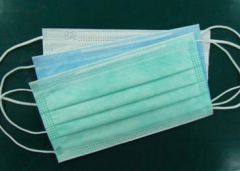 J-2763 SEMI-AUTOMATIC MASK PRODUCTION LINE WITH PACKING, 100 3-LAYER MASKS PER MINUTE - NEW
J-2763 SEMI-AUTOMATIC MASK PRODUCTION LINE WITH PACKING, 100 3-LAYER MASKS PER MINUTE - NEWCOMPOSED OF
SEMI-AUTOMATIC MASK PRODUCTION MACHINE
MASK DIMENSIONS: 17.5 x 9.5mm
CAPACITY: 80 TO 100 PIECES PER MINUTE
3 LAYERS
WITH ULTRASONIC SEALING
MATERIAL: POLYPROPYLENE FABRIC
TOTAL POWER CONSUMPTION: 3 KW
POWER SUPPLY: 220 VOLTS, 50 OR 60 Hz
DIMENSIONS: 3300mm x 630mm x 1850mm
QUANTITY: 1EAR LOOP ULTRASONIC WELDING MACHINES
QUANTITY: 4MASK PACKING MACHINE
Learn More
QUANTITY: 1 -
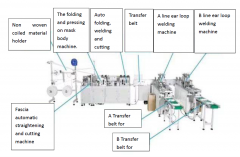 J-2733 COMPLETE AUTOMATIC PRODUCTION LINE FOR FACE MASKS – 140,000 PIECES PER 24-HOUR DAY
J-2733 COMPLETE AUTOMATIC PRODUCTION LINE FOR FACE MASKS – 140,000 PIECES PER 24-HOUR DAYPRODUCES FLAT MASKS AUTOMATICALLY: COILS STOCK, FOLDS AND PRESSES, MOLDS MASK, CUTS, LOADS AND WELDS EAR LOOPS, FINISHED PRODUCTS EXIT THE MACHINE
Learn More
MASKS ARE COMFORTABLE, NO PRESSURE, EASY TO WEAR AND PROVIDE GOOD FILTRATION
LINE FEATURES
ULTRASONIC WELDING MACHINE
HIGH SPEED PRODUCTION: 120,000 TO 140,000 PIECES PER 24-HOUR DAY
-APPROXIMATELY 90 TO 110 PIECES PER MINUTE
MODULAR AND PERSONNEL-FRIENDLY DESIGN WITH EASY MAINTENANCE
AUTOMATIC STOP AND ALARM FEATURE FOR MATERIAL BREAKAGE AND OTHER EXCEPTIONS, WITH ON-SCREEN HELP FOR CORRECTING THE BREAKAGE/EXCEPTIONS
DIMENSIONS: 6500mm LENGTH x 2500mm WIDTH x 1950mm HEIGHT
WEIGHT: </= 5000 KG
POWER: 220 VOLTS +/- 5% , 50 Hz, GROUND PROTECTION (OR AS PER CUSTOMER)
TOTAL KW: APPROXIMATELY 8.8 KW
AIR: 0.4 TO 0.6 MP (CLEAN AIR AFTER DEWATER, OIL-LESS, FILTRATION AND PRESSURE)
MAIN ACCESSORY: AIRTAC AIR CYLINDER
QUANTITY: 1 COMPLETE LINE (2 SETS CURRENTLY AVAILABLE MARCH 17TH)
